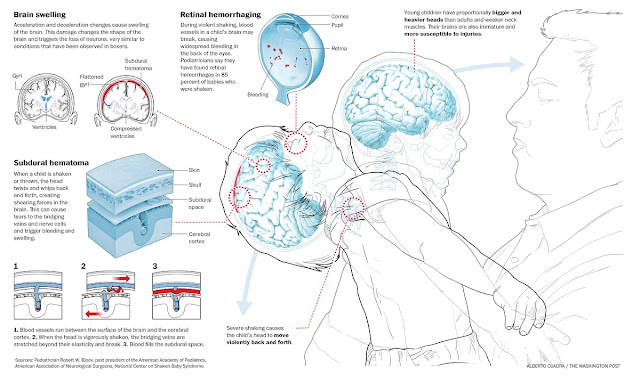Shaken Baby Syndrome, also known as SBS, is a severe form of child abuse that occurs when an infant or young child is violently shaken. This act can lead to devastating consequences, including brain damage, physical disabilities, and even death. It is crucial to understand the causes, recognize the symptoms, comprehend the long-term effects, and learn how to prevent this tragic condition. In this article, we will explore each of these aspects in detail.

What Causes Shaken Baby Syndrome?
The primary cause of Shaken Baby Syndrome is the violent shaking of an infant or toddler by an adult or older child. This typically happens when a caregiver becomes frustrated or overwhelmed, often due to the baby’s persistent crying. The following factors contribute to the occurrence of this syndrome:
- Frustration with Crying: Infants cry frequently, and sometimes their cries can be relentless. Caregivers who are unprepared for this reality may lose control and resort to shaking the baby in an attempt to stop the crying.
- Lack of Awareness: Many caregivers are unaware of the dangers associated with shaking a baby. They may not realize the fragility of an infant’s brain and the potential harm caused by such actions.
- Stress and Fatigue: Parents or caregivers dealing with stress, exhaustion, or mental health challenges may find it harder to cope with the demands of caring for a child, increasing the risk of impulsive and harmful behavior.
- Substance Abuse: The use of alcohol or drugs can impair judgment and increase aggression, making caregivers more likely to engage in abusive behavior.
Why Are Babies Vulnerable to Shaking?
Babies are particularly vulnerable to the effects of shaking because of their unique physical characteristics. Their neck muscles are not yet strong enough to support their relatively large and heavy heads. Additionally, their brains are still developing and are surrounded by a layer of fluid that provides some cushioning but is insufficient to protect against the forces generated during violent shaking. When a baby is shaken, the brain moves back and forth within the skull, causing bruising, swelling, and bleeding.
Symptoms of Shaken Baby Syndrome
Recognizing the symptoms of Shaken Baby Syndrome is critical for early intervention and treatment. These symptoms can vary depending on the severity of the injury and may not always be immediately apparent. Common signs include:
- Extreme Irritability: A baby who has been shaken may become unusually fussy or difficult to console.
- Vomiting: Frequent or projectile vomiting can indicate trauma to the brain.
- Seizures: Uncontrolled movements or convulsions are a serious sign of neurological damage.
- Lethargy: The baby may appear unusually sleepy or unresponsive.
- Breathing Difficulties: Labored breathing or pauses in breathing can occur as a result of brain injury.
- Pale or Bluish Skin: Changes in skin color may signal oxygen deprivation.
- Inability to Focus Eyes: The baby may have trouble tracking objects or focusing their gaze.
- Bulging Fontanel: The soft spot on the baby’s head may appear swollen or bulging.
Delayed Symptoms
In some cases, symptoms may not appear immediately after the incident. This delay can make it challenging to connect the injuries to the act of shaking. For example, internal bleeding or swelling in the brain might take hours or even days to manifest. Caregivers and medical professionals must remain vigilant and seek medical attention if there is any suspicion of abuse.
Effects of Shaken Baby Syndrome
The consequences of Shaken Baby Syndrome can be lifelong and profoundly impact both the child and their family. These effects range from physical disabilities to cognitive impairments and emotional challenges.
Physical Effects
The physical toll of Shaken Baby Syndrome can be severe and irreversible. Some of the most common physical effects include:
- Brain Damage: The forceful movement of the brain inside the skull can lead to permanent brain damage, affecting motor skills, speech, and other functions.
- Vision Problems: Retinal hemorrhages, or bleeding in the eyes, are a hallmark of Shaken Baby Syndrome and can result in partial or complete vision loss.
- Hearing Loss: Damage to the auditory system may cause hearing impairments.
- Cerebral Palsy: This condition, characterized by impaired muscle coordination, can develop as a result of brain injury.
- Paralysis: Severe cases may lead to partial or full paralysis of certain body parts.
Cognitive and Developmental Effects
Children who survive Shaken Baby Syndrome often face significant cognitive and developmental delays. These challenges can include:
- Learning Disabilities: Difficulties with reading, writing, and problem-solving are common among affected children.
- Memory Impairment: Short-term and long-term memory issues may arise due to brain damage.
- Speech Delays: Communication skills may be delayed or impaired.
- Behavioral Problems: Children may exhibit aggression, hyperactivity, or difficulty regulating emotions.
Emotional and Psychological Effects
Beyond the physical and cognitive impacts, Shaken Baby Syndrome can also affect a child’s emotional well-being. Survivors may struggle with:
- Anxiety and Depression: Emotional trauma can lead to mental health issues later in life.
- Social Challenges: Difficulty forming relationships or interacting with peers may occur due to developmental delays.
- Low Self-Esteem: Physical and cognitive limitations can contribute to feelings of inadequacy.
Prevention of Shaken Baby Syndrome
Preventing Shaken Baby Syndrome requires education, awareness, and proactive measures to support caregivers. By addressing the root causes and providing resources, we can reduce the incidence of this preventable tragedy.
Educating Caregivers
One of the most effective ways to prevent Shaken Baby Syndrome is through education. Parents, babysitters, and other caregivers should be informed about the dangers of shaking a baby and taught alternative strategies for managing frustration. Key educational points include:
- Understanding Infant Crying: Caregivers should know that crying is a normal part of infancy and does not necessarily indicate a problem.
- Safe Ways to Calm a Baby: Techniques such as swaddling, rocking, singing, or offering a pacifier can help soothe a crying infant.
- Recognizing Triggers: Identifying personal triggers for frustration and learning coping mechanisms can prevent impulsive actions.
Providing Support Systems
Support systems play a vital role in preventing child abuse. Families and caregivers need access to resources that can help them manage stress and build resilience. Examples of support systems include:
- Parenting Classes: These classes teach practical skills and provide a forum for discussing challenges.
- Mental Health Services: Counseling and therapy can address underlying issues such as anxiety, depression, or anger management problems.
- Respite Care: Temporary childcare services allow caregivers to take breaks and recharge, reducing the risk of burnout.
Raising Awareness
Public awareness campaigns can help spread the message about the dangers of Shaken Baby Syndrome. Hospitals, pediatricians, and community organizations can distribute informational materials and host workshops to educate the public. Social media platforms and traditional media outlets can also amplify these efforts by sharing stories and statistics related to child abuse prevention.
Legal and Policy Measures
Governments and institutions can implement policies to protect children and hold perpetrators accountable. Mandatory reporting laws require healthcare professionals, teachers, and others to report suspected cases of abuse. Additionally, stricter penalties for child abuse can serve as a deterrent to potential offenders.
Encouraging Open Communication
Finally, fostering open communication between caregivers and support networks is essential. Parents should feel comfortable seeking help without fear of judgment. Friends, family members, and neighbors can play a role by offering assistance and checking in regularly to ensure the well-being of both the child and the caregiver.





